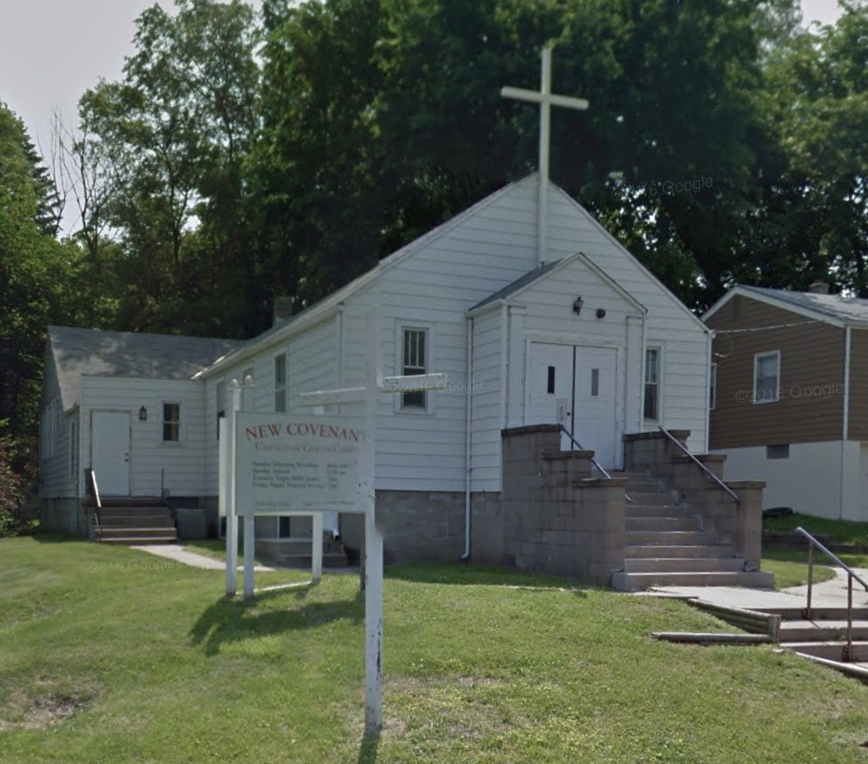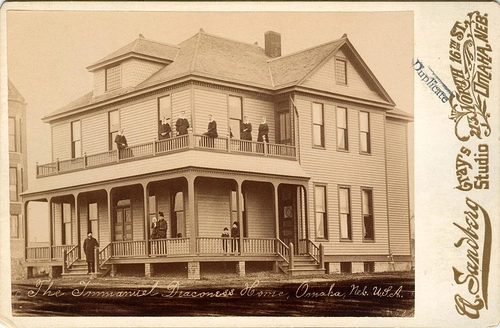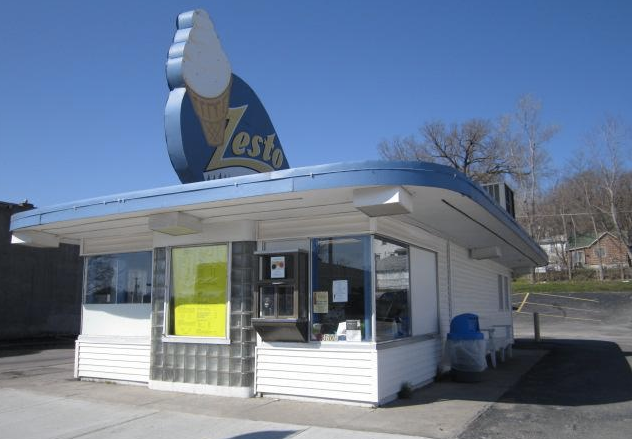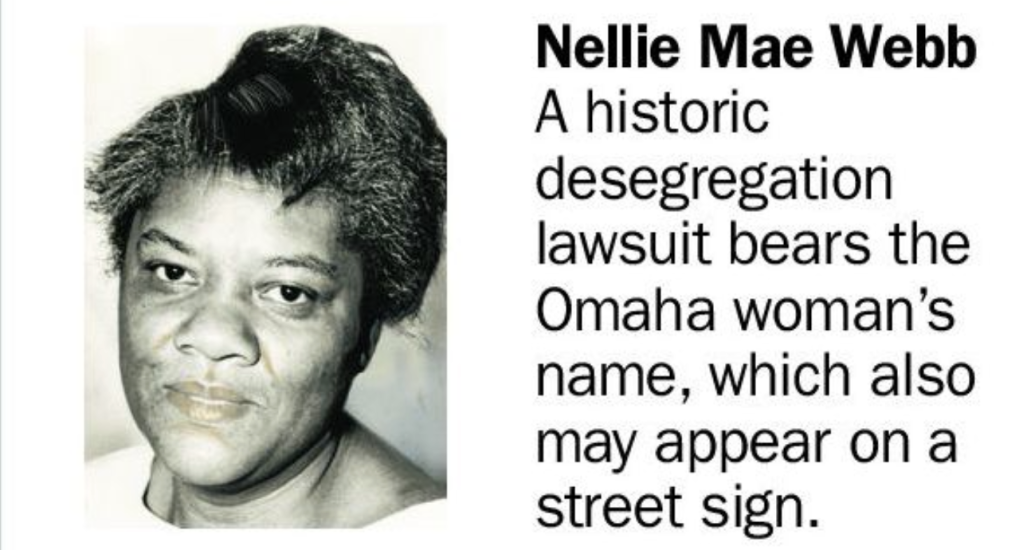Tucked away in North Omaha is a historic neighborhood that gets little attention. However, the people who’ve lived there have vibrant memories and meaningful stories that lasted a lifetime. The Central Park neighborhood extends from North 33rd to North 48th Streets, from Ames Avenue to Sorenson Parkway. It was never an incorporated town like its neighbors in Irvington or Benson, and a lot of the oral histories of the area talked about it being a rural community, surrounded by farms and fields, orchards and more. Rising from cornfields and hills, this neighborhood has a long history starting in the 1880s. Here is some history of the Central Park neighborhood in North Omaha.
A Country Crossroads
This area was settled in the 1870s and was called West Saratoga. With a schoolhouse and mercantile store, there were several of houses in the immediate area on large lots by 1879. In 1885, the West Saratoga School was built, and around the same time the area began to be called Cherry Hill instead. When the school was rebuilt later, it was called Central Park School, and the neighborhood was called Central Park after that. The country crossroad’s disassociation from Saratoga was complete by then.
Here are some details about the houses, businesses, faith communities and the school all once integral to the Central Park neighborhood.
The Houses of Central Park

Starting in the 1870s, farmers and visionaries began building their houses in a community called West Saratoga, and later Cherry Hill. Around the time the last cherry tree in the area was cut down in 1912, a developer rolled into the area and started developing homes en masse.
Despite being far from Omaha, he started calling the neighborhood Central Park, maybe because it was located in what was then the middle of nowhere.
Bordered by the Monmouth Park neighborhood, Central Park’s original houses were mostly large farmhouses with Victorian and Eastlake details. Those early homes were built in the 1870s and 1880s, and few exist still today.
The first big building blitz in the Central Park neighborhood happened in the late 1890s, filled many of the predominant streets with solid working class homes. The two-story homes were simple four squares, while the one-and-a-half-story houses were generally 1,000 square feet or less, which was affordable then.
By the 1950s, the last of the holdout farmers in the neighborhood subdivided their farmers into affordable lots. From my research, I’ve determined the Central Park neighborhood was completely filled in by 1954.
The Central Park School

Today’s Central Park School was built in 1912 at 4904 North 42nd Street in North Omaha. However, the original school was called Cherry Hill School and was opened by District 38 in the 1870s.
Starting in 1888, a four-room school sat on an acre with a white picket fence surrounding it was located at North 42nd and Grand Streets. Students rode horses to school, and boys and girls weren’t allowed to play together outside. After several additions were made to the school, in 1912, a new building opened with 13 rooms. This is the school that still stands. In 1966, an addition including a multi-purpose room and auditorium, a school cafeteria, additional classrooms, a kitchen, and several classrooms were added. There is a time capsule at front entrance corner of the building that sits unopened to this day since its placement in 1912.
The Golden Hill Cemetery

The Golden Hill Cemetery never stood alone. Sitting on a hill on North 42nd and Browne Streets, by the time Chevra B’nai Israel Adas Russia bought land there in 1888, there were already several homes and buildings in the area. It was largely seen as a rural cemetery into the 1920s. Today, its address is 5025 North 42nd Street, and it is a small cemetery with no new burials in it. In 1998, Nebraska Furniture Mart founder Rose Blumkin was buried there.
Today, the cemetery is still lovingly cared for, and although its been the target of vandalism over the years, the neighborhood largely respects the solemn beauty of such a historic landmark.
Learn more about Golden Hill Cemetery.
Central Park Congregational Church

Sunday School classes started in the Cherry Hill area in the 1870s, and were held at the school. In 1886, Rev. George Pelton founded the Saratoga Congregational Church congregation near North 24th and Ames Avenue. However, it was moved and renamed the Cherry Hill Congregational Church by 1912. In 1916, this second building was demolished. It’s basement was roofed over and used for several years, and in 1925, a new Spanish Renaissance Style building was opened at North 42nd and Saratoga Streets, with many additions since then. It was called the Central Park Congregational Church. Located five miles from downtown Omaha, the Congregationalists called it “the church of the laity,” which was also called “the country church in the city.” Located at 5001 North 42nd Street, the Congregationalists moved out in the 1990s, and today the building is home to True Vine Baptist Church.
The Businesses of Central Park
A collection of businesses huddled around Central Park School and the Central Park Church. The homes in the neighborhood were for working class people, and many of the businesses were for everyday families to use. In the 1920s, the Central Park Improvement Club succeeded in securing a streetcar line to the neighborhood, too. The streetcar company established a turnaround point in the area because it was the end of the line. Along with that, the neighborhood in-filled with homes and businesses sprung up.
Between 1924 and 1926, the intersection of North 42nd and Grand Avenue was completely filled with buildings and businesses. A Hinky Dinky store anchored the intersection, with a beauty shop and drug store on the same block. The Hinky Dinky later became an IGA. A candy store called Edith’s candy was located on the southeast corner, featuring homemade candies where you could buy a bag of broken mints for a penny. According to neighborhood native Terry Beals, there were two other stores at the intersection, O.P. Skaggs and Hadley’s Grocery Store.
Nolan Mauro, a local historian, conducted research to learn more about the neighborhood. He found that during the 1960s, the intersection of North 42nd and Grand Avenue was packed with businesses. There was a variety store on the southwest corner was owned by Fran and Anne Veylupek, originally opened by Ed and Stella Woodworth. At the same time, there was a flower shop on the southeast corner. Dr. Carl Walvord kept an office next door to the Central Park Pharmacy, where the doctor saw patients on a first come, first serve basis. There was a shoe repair shop just north of Hadley’s Grocery Store.

A local historical researcher named Nolan Mauro has found that 4135 Grand Avenue was originally a part of a single structure divided into four separate storefronts. It is a simple, one-story rectangular building that has had many lives of its own, highlighting the changing needs and wants in the area as the people of the neighborhood have changed.
Built as the J.P. Morris grocery store, over the years several grocery stores were located there. In 1942, the Grand Avenue Grocery occupied the space, and in 1947 a new grocery store chain called O.P. Skaggs became the third business to inhabit the building. In 1949 the store became part of the IGA chain. After closing in the late 1950s, the store became Sharon’s Market, which held a closing auction in 1964. By 1966, a pizza shop called Pinkey’s Palace was open in the building. Bricks Bike shop moved in by the end of 1972, and in 1980, Little Angels Day Care Center held an open house there. Today, the building remains a daycare and is currently occupied by Kashay’s Childcare Learning Center. Today, the building on the southeast corner of North 42nd and Grand Avenue is one of the few in the area that has been refurbished.
North of the former Central Park Pharmacy, Nolan Mauro uncovered the history of 4907 North 42nd Street. Its a small storefront with a long history. Built in 1927 as a Spic and Span Grocery Store, it was replaced by a Hinky Dinky in 1930. For nearly a decade in the 1940s, the storefront was home to a Hadassah Group, which was a Jewish women’s Zionist organization focused on women’s empowerment. By the mid-1950s it was the Hadley Grocery, and by 1970 it had become a construction company’s office. After becoming the Foyer Barbershop in the 1980s and a fashion boutique in the 1990s, the building was boarded up in the late 1990s and has remained that way since.
Special Place: Central Park Pharmacy

In a league of its own, the Central Park Pharmacy was located on the northeast corner of North 42nd and Grand Streets at 4136 Grand Avenue. It was open for more than 50 years. In the photo above, you can see signs everywhere around the building, including “Harding’s Ice Cream”, “Cook’s Paints,” and a Coca Cola ad, as well as features in the store including courteous service, glass, sodas, fresh candies, prescriptions, Kodaks and films, toilet articles, as well as ice cream and malted milk.
Cherry phosphates and a penny candy corner stock at the pharmacy many peoples’ memories today. Located katty corner to the Central Park School, the pharmacy was the location for many students’ afterschool and weekend trips to buy comic books, candy, sodas and more.
While it was owned by George Cox for almost three decades from the 1930s, he offered a warm place for streetcar riders to wait, and later, bus riders. The streetcar turned north onto North 42nd street, then backed up onto Grand to wait for passengers. From there, it turned around and went south on North 42nd. He also kept the store in great condition.
Jim Geisler and Jim Luke Coniglio bought the business in 1961 and were the last owners of Central Park Pharmacy before it closing it permanently in the 1980s. Don Jacox, a manager at the store, ordered general merchandise, cut glass, mixed paint, cut keys, ran the soda fountain, and did almost every non-pharmacy activity at the store. After it closed, the building was boarded up and hasn’t been open to the public in more than 35 years. It still stands today.
The Churches of Central Park

Churches in the neighborhood include the New Covenant Church of God in Christ at 5325 North 42nd Street. That building was constructed in 1945 as Gethsemane Lutheran Church, which moved to west Omaha in the 1970s. The Shiloh Church of God in Christ, also called the Smith Temple Church of God in Christ, is located at 5416 Fontenelle Boulevard, was built in 1930. Mount Olivet Baptist Church was located at North 38th and Grand Avenue for several decades, and in the 1990s, a Vietnamese Buddhist faith community called Quoc An Temple opened at 3812 Fort Street. The Hadassad Group mentioned in the previous section served Jewish women in the 1940s, and along with the historical Golden Hill Cemetery just up the street, indicates there was a notable population of Jewish people throughout the neighborhood too.
Central Park Improvement Club

Active starting in the 1890s, the Central Park Improvement Club was an advocacy group that lobbied for positive changes within the neighborhood. Calling early on for graded streets, getting streetlights installed through the neighborhood, lobbying the streetcar company to extend a line to the neighborhood, and getting the school district to add onto the school building were all activities led by the club. They also advocated for the development of Fontenelle Park, and against the dumping of dead animals in a pit at North 42nd and Fowler. Leaders with the club were also active in representing the neighborhood in citywide activities, too.
White Flight
Starting in the 1970s and earlier, white flight struck the Central Park neighborhood drastically. US Census data shows white families moving from this area en masse between 1970 and 1990, with the majority of the population made of people of color now. With white flight, it should be no surprise that the value of the homes has not kept pace with national averages, either.
This trend is typical throughout North Omaha, with white flight dominating the cultural landscape since 1919. Through a series of policies, local and federal governments have supported white flight. Central Park joins neighborhoods including Miller Park, Saratoga, Kountze Place and others that have emptied out of white people since the 1970s.
While these white families have moved to west Omaha and elsewhere, it should come as no surprise that they left faltering schools, toxic pollution and social instability in their wake. Meanwhile, Central Park and other neighborhoods have become predominantly low-income and strategically targeted by the City of Omaha, banks and others to keep maintenance low-income people in North Omaha through low rents, poor public transportation, and strategically placed businesses for families that can’t afford to shop elsewhere. This trifecta has left Central Park in a challenging position for rallying to maintain the sense of community and place-based loyalty it enjoyed for a century.
Modern Times in Central Park
The Central Park School continues to be a bedrock of the neighborhood. Almost all of the businesses have left the neighborhood though, and many homeowners have transitioned out of the neighborhood. White flight struck the Central Park neighborhood late, with white people fleeing only in the 1980s. Today, the majority of the neighborhood is occupied by people of color, and is owned by absentee landlords.
The future of the neighborhood maybe uncertain, but if the past is any indication, the future might be outstanding.
You Might Like…
- A History of the Intersection of North 42nd and Redman Avenue
- A History of the Saratoga Neighborhood
- A History of Historic Neighborhoods in North Omaha
- North Omaha History Podcast Episode #71: The History of the Central Park Neighborhood

MY ARTICLES ABOUT HISTORIC NEIGHBORHOODS IN NORTH OMAHA
National Register of Historic Places Historic Districts in North Omaha: 24th and Lake Historic District | Benson Downtown Historic District | Country Club Historic District | Dundee/Happy Hollow Historic District | Fairacres Historic District | Fort Omaha Historic District | Minne Lusa Historic District | Nicholas Street Historic District
Historic Neighborhoods in North Omaha: Bedford Place | Belvedere Point | Bemis Park | Benson | Briggs | Bungalow City | Carter Lake, Iowa | Central Park | Clifton Hill | Collier Place | Creighton University | Crown Point | DeBolt | Druid Hill | East Omaha | Fairfax | Florence | Florence Field | Fort Omaha | Fontenelle View | Gifford Park | Gold Coast (Cathedral) | High Point | Jefferson Square | Kellom Heights | Kountze Place | Lakewood Gardens | Little Russia | Long School | Malcolm X Memorial | Miller Park | Miller Park Duplex Historic District | Monmouth Park | Montclair | Near North Side | North Downtown Omaha | Omaha View | Orchard Hill | Plum Nelly | Prettiest Mile in Omaha | Prospect Place | Raven Oaks | Redman | Saratoga | Sherman | Squatter’s Row | Sulphur Springs | Ponca Hills | Wakonda | Walnut Hill | Winspear Triangle | Wyman Heights
Lost Towns in North Omaha: Benson | Briggs | DeBolt | East Omaha | Florence | Saratoga | Sulphur Springs
Bonus Pics!










Leave a comment